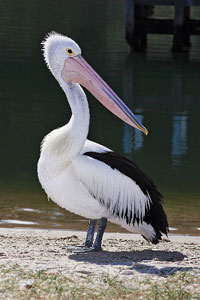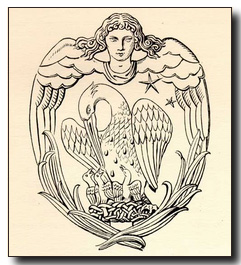Tom Parkinson's monthly column, introducing the diverse range of flora and fauna on show at Sanctuary Lakes.
 A wonderful bird is the Pelican.
A wonderful bird is the Pelican.
His beak can hold more than his belly can.
He can hold in his beak
Enough food for a week!
But I'll be darned if I know how the hellican?
Limerick attributed to Edward Lear
One of Sanctuary Lakes’ most wonderful natural sights is to watch a Pelican touching down. It lands like an amphibious aeroplane on a watery runway, finally gilding to a stop with the help of its wings spread out acting like brakes and its webbed feet switching from near vertical to horizontal as they touch the water. Equally fantastic is to see a Pelican take off, running across the water to build up speed and flapping its huge wings. Once in the air, this big bird stops multiple flapping, stretches its wings and relies on thermals, soaring to great heights and for long distances. It has been reported that Australian pelicans have soared to a height of 3,000 meters (3 km) and have been known to travel a 1,000 km within 24 hours. Occasionally a flying flock of Pelicans are seen in a rough V formation above the Resort, a momentary second glance later and they seem to have disappeared, raced to greater heights or distances by the fast moving thermals.
The Australian Pelican (Pelecanus conspicillatus) is the only one of the Pelican family found in Australia and is the largest of the 8 worldwide species of Pelican. (For completeness the other seven are American White, Great White, Peruvian, Spotted Bill Grey, Pacific Brown, Dalmatian, and Pink Backed). The name Pelecanus conspicillatus was given in 1824 by the Dutch naturalist Jacob Temminck. Concpicillatus is Latin for conspicuous which they indeed are. There is much we know about the Pelican but equally there’s a lot we don’t. The Pelican is wrapped in its cloak of mysteries and in its past was often the subject of myths.
First what we do know: for a starter the Australian Pelican has the largest beak (50cms) and the lightest bones of any bird in the world. Its wing span is between 2.3 to 2.6 m. Weight can range between 4.54 and 7.7 kg. They are predominantly white in colour, with a white panel on the upper-wing and a white-V on the rump set against black along the primaries. During courtship, the orbital skin and distal quarter of the bill are orange-coloured with the pouch variously turning dark blue, pink and scarlet.
Australian Pelicans are voracious eaters, consuming up to 9 kg of food per day, and they are not picky eaters. Besides fish, they regularly feed on many aquatic crustaceans, especially the common yabby and shrimps. The bill and pouch of pelicans play an important role in feeding. The bill is sensitive and this helps locate fish in murky water. It also has a hook at the end of the upper mandible, probably for gripping slippery food items. When food is caught, the pelican manipulates it in its bill until the prey typically has its head pointing down the pelican's throat. Then with a jerk of the head the pelican swallows the prey. The bill is delicately built. The lower jaw consists of two thin and weakly articulated bones from which the pouch hangs. Once something is caught, a pelican draws its pouch to its breast. Pelicans are also known to take other birds, such as fledgling and adult, silver gulls and coots which they kill by pinning them underwater and drowning them. Reptiles and amphibians are also taken when available.
Depending on rainfall, breeding may occur at any time of the year, usually in isolated places such as small, uninhabited islands. Courtship begins with a group of males trying to attract the attention of a single female by swinging their open bills back and forth, rippling their pouches, tossing and catching various objects. When one male outlasts the others, the female will choose a nest site, dig a hole in the ground with her bill and feet and line with plants and feathers. She lays up to 3 eggs. Over the next 32 to 35 days, both parents will incubate the eggs with their feet. A month after hatching, the chicks form cohorts of up to 100 birds and begin the two-month long process of learning to fly and survive independently. The Australian Pelican is known to live in the wild for up to twenty five years.
Now what we don’t know; how Pelicans communicate. The Australian Pelican is a very social bird yet it cannot produce true vocal sounds, due to the absence of syrinx and associated muscles. They are able to produce primitive yelps, hissing, grunting and bill-clapping but nothing that tells us how they are able to communally flock together in their thousands and fly to unknown inland lakes. When the normally dried out Lake Eyre filled with fresh water and fishy food during 1974–1977 and 1999-2001 and again in 2009-2011, ninety percent of the Australian Pelican population (approximately 120,000) up stakes and flew to Lake Eyre: when the great inland lakes dried again, the population dispersed once more, back to South and East Coast.
After decades of research, nobody knows how the birds are aware that Lake Eyre had been flooded, or how they knew the way there from their coastal homes, thousands of kilometres away. Adelaide Zoo research scientist Greg Johnston says there is a theory that the pelican breeding colonies act as information centres, each bird passing on information about good feeding grounds, but without vocal chords how do they pass this relatively complex information. There are other theories too, including birds having the ability to hear sonic vibrations or pick up on waves lapping at the shores or smell the masses of water in creek systems, or magnetic compasses in their brains working on the magnetic forces on Earth. At least the theory of being communicated by aliens has been discarded.
The ancestral Pelican family is the oldest recorded living bird species; fossilised bones over 40 million years old have been discovered in the Americas. Obviously at that age numerous myths and legends have been associated with Pelicans
 One famous mythical story, of the mother pelican feeding her little baby pelicans by striking her breast with the beak to feed her young with her blood to prevent starvation but in turn loses her own life, is rooted in an ancient legend which preceded Christianity. The Legend does appear in the Physiologus, an early Christian work written in the second century in Alexandria, Egypt. The myth was adapted into the Eucharist by the early Christians symbolizing Jesus giving his blood and life for redemption and atonement. The pelican myth is now out of fashion due mainly to the fact that it was found mother pelicans did not beat their breast to raise blood to feed their young off-springs. But the visual symbol of the bleeding pelican remains in icon painting and carving within the Orthodox Church.
One famous mythical story, of the mother pelican feeding her little baby pelicans by striking her breast with the beak to feed her young with her blood to prevent starvation but in turn loses her own life, is rooted in an ancient legend which preceded Christianity. The Legend does appear in the Physiologus, an early Christian work written in the second century in Alexandria, Egypt. The myth was adapted into the Eucharist by the early Christians symbolizing Jesus giving his blood and life for redemption and atonement. The pelican myth is now out of fashion due mainly to the fact that it was found mother pelicans did not beat their breast to raise blood to feed their young off-springs. But the visual symbol of the bleeding pelican remains in icon painting and carving within the Orthodox Church.
Even though swathed in Mystery and Myth, it will always be a comforting pleasure to see these complex giant birds feeding on our Lake and waddling on the beaches. A sure sign that the hard work of keeping the lake healthy is paying off and it abounds with food for Pelicans and Cormorants alike.
King and Queen of the Pelicans we;
No other Birds so grand we see!
None but we have feet like fins!
With lovely leathery throats and chins!
Opening verse of “Pelican Chorus” by Edward Lear